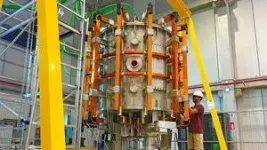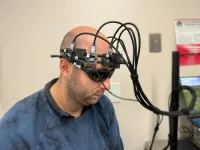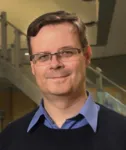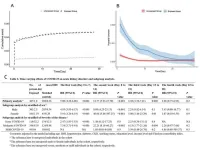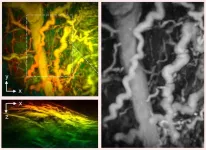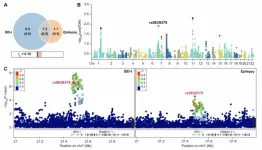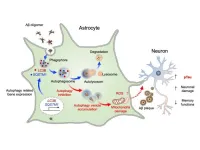(Press-News.org) Like atoms coming together to release their power, fusion researchers worldwide are joining forces to solve the world’s energy crisis. Harnessing the power of fusing plasma as a reliable energy source for the power grid is no easy task, requiring global contributions.
The Princeton Plasma Physics Laboratory (PPPL) — a U.S. national laboratory funded by the Department of Energy (DOE) — is leading several efforts on this front, including collaborating on the design and development of a new fusion device at the University of Seville in Spain. The SMall Aspect Ratio Tokamak (SMART) strongly benefits from PPPL computer codes as well as the Lab’s expertise in magnetics and sensor systems.
“The SMART project is a great example of us all working together to solve the challenges presented by fusion and teaching the next generation what we have already learned,” said Jack Berkery, PPPL’s deputy director of research for the National Spherical Torus Experiment-Upgrade (NSTX-U) and principal investigator for the PPPL collaboration with SMART. “We have to all do this together or it’s not going to happen.”
Manuel Garcia-Munoz and Eleonora Viezzer, both professors at the Department of Atomic, Molecular and Nuclear Physics of the University of Seville as well as co-leaders of the Plasma Science and Fusion Technology Lab and the SMART tokamak project, said PPPL seemed like the ideal partner for their first tokamak experiment. The next step was deciding what kind of tokamak they should build. “It needed to be one that a university could afford but also one that could make a unique contribution to the fusion landscape at the university scale,” said Garcia-Munoz. “The idea was to put together technologies that were already established: a spherical tokamak and negative triangularity, making SMART the first of its kind. It turns out it was a fantastic idea.”
SMART should offer easy-to-manage fusion plasma
Triangularity refers to the shape of the plasma relative to the tokamak. The cross section of the plasma in a tokamak is typically shaped like the capital letter D. When the straight part of the D faces the center of the tokamak, it is said to have positive triangularity. When the curved part of the plasma faces the center, the plasma has negative triangularity.
Garcia-Munoz said negative triangularity should offer enhanced performance because it can suppress instabilities that expel particles and energy from the plasma, preventing damage to the tokamak wall. “It’s a potential game changer with attractive fusion performance and power handling for future compact fusion reactors,” he said. “Negative triangularity has a lower level of fluctuations inside the plasma, but it also has a larger divertor area to distribute the heat exhaust.”
The spherical shape of SMART should make it better at confining the plasma than it would be if it were doughnut shaped. The shape matters significantly in terms of plasma confinement. That is why NSTX-U, PPPL’s main fusion experiment, isn’t squat like some other tokamaks: the rounder shape makes it easier to confine the plasma. SMART will be the first spherical tokamak to fully explore the potential of a particular plasma shape known as negative triangularity.
PPPL’s expertise in computer codes proves essential
PPPL has a long history of leadership in spherical tokamak research. The University of Seville fusion team first contacted PPPL to implement SMART in TRANSP, a simulation software developed and maintained by the Lab. Dozens of facilities use TRANSP, including private ventures such as Tokamak Energy in England.
“PPPL is a world leader in many, many areas, including fusion simulation; TRANSP is a great example of their success,” said Garcia-Munoz.
Mario Podesta, formerly of PPPL, was integral to helping the University of Seville determine the configuration of the neutral beams used for heating the plasma. That work culminated in a paper published in the journal Plasma Physics and Controlled Fusion.
Stanley Kaye, director of research for NSTX-U, is now working with Diego Jose Cruz-Zabala, EUROfusion Bernard Bigot Researcher Fellow, from the SMART team, using TRANSP “to determine the shaping coil currents necessary for attaining their design plasma shapes of positive triangularity and negative triangularity at different phases of operation.” The first phase, Kaye said, will involve a “very basic” plasma. Phase two will have neutral beams heating the plasma.
Separately, other computer codes were used for assessing the stability of future SMART plasmas by Berkery, former undergraduate intern John Labbate, who is, now a grad student at Columbia University, and former University of Seville graduate student Jesús Domínguez-Palacios, who has now moved to an American company. A new paper in Nuclear Fusion by Domínguez-Palacios discusses this work.
Designing diagnostics for the long haul
The collaboration between SMART and PPPL also extended into and one of the Lab’s core areas of expertise: diagnostics, which are devices with sensors to assess the plasma. Several such diagnostics are being designed by PPPL researchers. PPPL Physicists Manjit Kaur and Ahmed Diallo, together with Viezzer, are leading the design of the SMART’s Thomson scattering diagnostic, for example. This diagnostic will precisely measure the plasma electron temperature and density during fusion reactions, as detailed in a new paper published in the journal Review of Scientific Instruments. These measurements will be complemented with ion temperature, rotation and density measurements provided by diagnostics known as the charge exchange recombination spectroscopy suite developed by Alfonso Rodriguez-Gonzalez, graduate student at University of Seville, Cruz-Zabala and Viezzer.
“These diagnostics can run for decades, so when we design the system, we keep that in mind,” said Kaur. When developing the designs, it was important the diagnostic can handle temperature ranges SMART might achieve in the next few decades and not just the initial, low values, she said.
Kaur designed the Thomson scattering diagnostic from the start of the project, selecting and procuring its different subparts, including the laser she felt best fits the job. She was thrilled to see how well the laser tests went when Gonzalo Jimenez and Viezzer sent her photos from Spain. The test involved setting up the laser on a bench and shooting it at a piece of special parchment that the researchers call “burn paper.” If the laser is designed just right, the burn marks will be circular with relatively smooth edges. “The initial laser test results were just gorgeous,” she said. “Now, we eagerly await receiving other parts to get the diagnostic up and running.”
James Clark, a PPPL research engineer whose doctoral thesis focused on Thomson scattering systems, was later brought on to work with Kaur. “I’ve been designing the laser path and related optics,” Clark explained. In addition to working on the engineering side of the project, Clark has also helped with logistics, deciding how and when things should be delivered, installed and calibrated.
PPPL’s Head of Advanced Projects Luis Delgado-Aparicio, together with Marie Skłodowska-Curie fellow Joaquin Galdon-Quiroga and University of Seville graduate student Jesus Salas-Barcenas, are leading efforts to add two other kinds of diagnostics to SMART: a multi-energy, soft X-ray (ME-SXR) diagnostic and spectrometers. The ME-SXR will also measure the plasma’s electron temperature and density but using a different approach than the Thomson scattering system. The ME-SXR will use sets of small electronic components called diodes to measure X-rays. Combined, the Thomson scattering diagnostic and the ME-SXR will comprehensively analyze the plasma’s electron temperature and density.
By looking at the different frequencies of light inside the tokamak, the spectrometers can provide information about impurities in the plasma, such as oxygen, carbon and nitrogen. “We are using off-the-shelf spectrometers and designing some tools to put them in the machine, incorporating some fiber optics,” Delgado-Aparicio said. Another new paper published in the Review of Scientific Instruments discusses the design of this diagnostic.
PPPL Research Physicist Stefano Munaretto worked on the magnetic diagnostic system for SMART with the field work led by University of Seville graduate student Fernando Puentes del Pozo Fernando. “The diagnostic itself is pretty simple,” said Munaretto. “It’s just a wire wound around something. Most of the work involves optimizing the sensor’s geometry by getting its size, shape and length correct, selecting where it should be located and all the signal conditioning and data analysis involved after that.” The design of SMART’s magnetics is detailed in a new paper.
Munaretto said working on SMART has been very fulfilling, with much of the team working on the magnetic diagnostics made up of young students with little previous experience in the field. “They are eager to learn, and they work a lot. I definitely see a bright future for them.”
Delgado-Aparicio agreed. “I enjoyed quite a lot working with Manuel Garcia-Munoz, Eleonora Viezzer and all of the other very seasoned scientists and professors at the University of Seville, but what I enjoyed most was working with the very vibrant pool of students they have there,” he said. “They are brilliant and have helped me quite a bit in understanding the challenges that we have and how to move forward toward obtaining first plasmas.”
Researchers at the University of Seville have already run a test in the tokamak, displaying the pink glow of argon when heated with microwaves. This process helps prepare the tokamak’s inner walls for a far denser plasma contained at a higher pressure. While technically, that pink glow is from a plasma, it’s at such a low pressure that the researchers don’t consider it their real first tokamak plasma. Garcia-Munoz says that will likely happen in the fall of 2024.
Support for this research comes from the DOE under contract number DE-AC02-09CH11466, European Research Council Grant Agreements 101142810 and 805162, the Euratom Research and Training Programme Grant Agreement 101052200 — EUROfusion, and the Junta de Andalucía Ayuda a Infraestructuras y Equipamiento de I+D+i IE17-5670 and Proyectos I+D+i FEDER Andalucía 2014-2020, US-15570.
________________________________________________________________________________________
PPPL is mastering the art of using plasma — the fourth state of matter — to solve some of the world's toughest science and technology challenges. Nestled on Princeton University’s Forrestal Campus in Plainsboro, New Jersey, our research ignites innovation in a range of applications including fusion energy, nanoscale fabrication, quantum materials and devices, and sustainability science. The University manages the Laboratory for the U.S. Department of Energy’s Office of Science, which is the nation’s single largest supporter of basic research in the physical sciences. Feel the heat at https://energy.gov/science and https://www.pppl.gov.
The Plasma Science and Fusion Technology Lab of the University of Seville hosts the SMall Aspect Ratio Tokamak and leads several worldwide efforts on energetic particles and plasma stability towards the development of magnetically confined fusion energy. www.psft.eu
END
A new and unique fusion reactor comes together with PPPL's contributions
First plasma is coming soon to the University of Seville’s compact spherical tokamak called SMART
2024-09-30
ELSE PRESS RELEASES FROM THIS DATE:
Reduced risk of serious cardiovascular disease after COVID vaccination
2024-09-30
People who have been fully vaccinated against COVID-19 have a significantly lower risk of developing more severe cardiovascular conditions linked to COVID-19 infection, according to a nationwide study at the University of Gothenburg. At the same time, some cardiovascular effects are seen after individual doses of the vaccine.
The COVID-19 vaccine aims to reduce complications and overall mortality from the disease. At the same time, some cardiovascular effects have been seen after individual doses of the vaccine. A rare acute side effect is inflammation of the cardiac muscle or the pericardium in young men following mRNA vaccination. In terms of other cardiovascular ...
New laser-based headset can measure blood flow, assess risk of stroke
2024-09-30
When physicians want to know more about a patient’s risk of cardiovascular disease, they can order a cardiac stress test. But when it comes to risk of stroke, there is no equivalent scalable and cost-effective test of the brain’s function to help physicians counsel patients on their potential risk. A questionnaire that asks patients about contributing risk factors is currently the best tool for estimating such risk.
Now a team of engineers and scientists from Caltech and the Keck School ...
Researchers close in on understanding possible cause of Alzheimer’s disease
2024-09-30
CLEVELAND—With a four-year, $3.3 million grant from the National Institutes of Health (NIH), researchers from Case Western Reserve University will study whether certain brain proteins may play a role in the development of Alzheimer’s disease.
Alzheimer’s disease is a brain disorder that slowly destroys memory and thinking skills. According to the Alzheimer’s Association, nearly 7 million Americans 65 and older are living with the disease and there are more deaths from Alzheimer’s than breast and prostate cancer combined.
Previous research has ...
New synthesis strategy could speed up PFAS decontamination
2024-09-30
HOUSTON – (Sept. 30, 2024) – Rice University engineers have developed an innovative way to make covalent organic frameworks (COFs), special materials that can be used to trap gases, filter water and speed up chemical reactions. COFs have the potential to address significant environmental challenges, including energy storage and pollution control. An example of that is their potential use in the decontamination of “forever chemicals” or per- and polyfluoroalkyl substances (PFAS).
Rice chemical engineer Rafael Verduzco and his team have described a new way to synthesize high-quality ...
COVID-19 linked to increased risk of acute kidney disorders: New study reveals time-varying effects
2024-09-30
Researchers from West China Hospital, Sichuan University, have conducted a study revealing a significant association between COVID-19 and acute kidney disorders (AKD), including acute kidney injury (AKI), that varies over time. The study, led by Dr. Li Chunyang and Dr. Zeng Xiaoxi from the West China Biomedical Big Data Center, was recently published in the journal Health Data Science.
COVID-19, known for its impact on the respiratory system, also affects other organs, including the kidneys. The study aimed to investigate the time-dependent effects of COVID-19 on acute kidney disorders. Using data from the ...
Medical imaging breakthrough could transform cancer and arthritis diagnosis
2024-09-30
A new hand-held scanner developed by UCL researchers can generate highly detailed 3D photoacoustic images in just seconds, paving the way for their use in a clinical setting for the first time and offering the potential for earlier disease diagnosis.
In the study, published in Nature Biomedical Engineering, the team show their technology can deliver photoacoustic tomography (PAT) imaging scans to doctors in real time, providing them with accurate and intricate images of blood vessels, helping inform patient care.
Photoacoustic ...
Genetic link between bipolar disorder and epilepsy unveiled in groundbreaking study
2024-09-30
Kunming, China - A team of researchers from the Chinese Academy of Sciences has uncovered compelling evidence of a genetic link between bipolar disorder type I (BD-I) and epilepsy, potentially revolutionizing our understanding of these complex neuropsychiatric conditions. The study, published in Genomic Psychiatry on September 30, 2024, reveals shared genetic variants and a causal relationship between the two disorders, opening new avenues for research and treatment.
Led by Dr. Ming Li from the Kunming ...
Social networks help people resolve welfare problems - but only sometimes, new research finds
2024-09-30
Lead researcher Dr Sarah Nason, from Bangor University’s School of History, Law and Social Sciences explained: “Debt, benefits, special educational needs, healthcare issues, these are everyday problems that many of us face, and it’s only natural to turn to people you know and trust for help and advice. However, we found that having to talk to more people or support services was an indicator that the problem was more complex and difficult to resolve.”
The team studied four distinct areas across England and Wales: Bryngwran, a village on Anglesey in North Wales; Deeplish, a district of Rochdale in Greater ...
Honey, I shrunk the city: What should declining Japanese cities do?
2024-09-30
Aging societies and population decline have been on the rise globally, but in Japan, the situation has exasperated tenfold. A staggering 36.21 million people, or 28.9% of the populace, are 65 and over. Further, 74.6% of Japan’s 1,747 cities are categorized as shrinking, with urban policies struggling to keep up with the decline. However, the factors that correlate with population changes in cities of varying sizes have not been clarified.
Dr. Haruka Kato, a junior associate professor at Osaka Metropolitan University, ...
New brain cell cleaner: astrocytes raise possibility of Alzheimer’s disease treatment
2024-09-30
A research team led by Dr. Hoon Ryu from the Korea Institute of Science and Technology (KIST, President Sang-Rok Oh) Brain Disease Research Group, in collaboration with Director Justin C. Lee of the Institute for Basic Science (IBS, President Do-Young Noh) and Professor Junghee Lee from Boston University Chobanian & Avedisian School of Medicine, has uncovered a new mechanism involving astrocytes for treating Alzheimer’s disease (AD) and proposed a novel therapeutic target. In this study, the researchers revealed that autophagy pathway ...
LAST 30 PRESS RELEASES:
Heart-brain connection: international study reveals the role of the vagus nerve in keeping the heart young
Researchers identify Rb1 as a predictive biomarker for a new therapeutic strategy in some breast cancers
Survey reveals ethical gaps slowing AI adoption in pediatric surgery
Stimulant ADHD medications work differently than thought
AI overestimates how smart people are, according to HSE economists
HSE researchers create genome-wide map of quadruplexes
Scientists boost cell "powerhouses" to burn more calories
Automatic label checking: The missing step in making reliable medical AI
Low daily alcohol intake linked to 50% heightened mouth cancer risk in India
American Meteorological Society announces Rick Spinrad as 2026 President-Elect
Biomass-based carbon capture spotlighted in newly released global climate webinar recording
Illuminating invisible nano pollutants: advanced bioimaging tracks the full journey of emerging nanoscale contaminants in living systems
How does age affect recovery from spinal cord injury?
Novel AI tool offers prognosis for patients with head and neck cancer
Fathers’ microplastic exposure tied to their children’s metabolic problems
Research validates laboratory model for studying high-grade serous ovarian cancer
SIR 2026 delivers transformative breakthroughs in minimally invasive medicine to improve patient care
Stem Cell Reports most downloaded papers of 2025 highlight the breadth and impact of stem cell research
Oxford-led study estimates NHS spends around 3% of its primary and secondary care budget on the health impacts of heat and cold in England
A researcher’s long quest leads to a smart composite breakthrough
Urban wild bees act as “microbial sensors” of city health.
New study finds where you live affects recovery after a hip fracture
Forecasting the impact of fully automated vehicle adoption on US road traffic injuries
Alcohol-related hospitalizations from 2016 to 2022
Semaglutide and hospitalizations in patients with obesity and established cardiovascular disease
Researchers ‘listen in’ to embryo-mother interactions during implantation using a culture system replicating the womb lining
How changing your diet could help save the world
How to make AI truly scalable and reliable for real-time traffic assignment?
Beyond fragmented markets: A new framework for efficient and stable ride-pooling
Can shape priors make road perception more reliable for autonomous driving?
[Press-News.org] A new and unique fusion reactor comes together with PPPL's contributionsFirst plasma is coming soon to the University of Seville’s compact spherical tokamak called SMART

